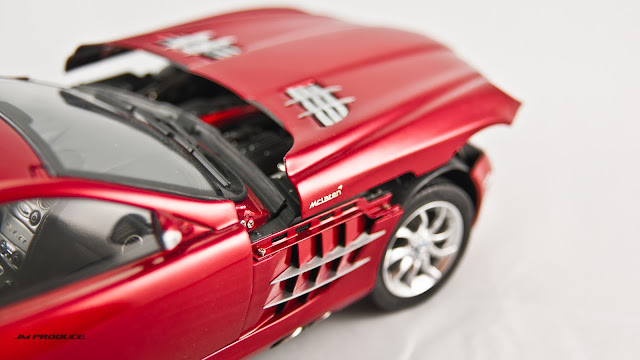History
The Mercedes-Benz SLR McLaren was inspired by the Mercedes-Benz 300 SLR Uhlenhaut Coupe & Racecar of 1955, which was a modified Mercedes-Benz W196 F1 race car. It was introduced on 17 Nov 2003. On 4 April 2008, Mercedes announced that they would cease production of the SLR. The last of the coupes rolled off the production line at the end of 2007 and the roadster version was discontinued in early 2009.
Technical highlights
Brakes
The SLR features Sensotronic, a type of brake-by-wire system. The brake discs are carbon-ceramic and provide better stopping power and fade resistance than steel discs when operating under ideal working temperature. Mercedes-Benz claims these discs are fade resistant to 1,200 °C (2,200 °F). The front discs are internally vented and 370 mm (15 in) in diameter. 8 piston calipers are used. Rear discs are 360 mm (14 in) in diameter with 4 piston calipers. During wet conditions the calipers automatically skim the surface of the discs to keep them dry.
To improve braking performance there is an automatic air brake, when engaged the rear elevation angle of the rear spoiler is set to 65 degrees. The additional rear downforce in addition to the markedly increased aerodynamic drag increases peak deceleration ~90%[citation needed].
The brakes have been strongly criticized by such review sources as Top Gear for lacking modulation and having an on-and-off operation. This is due to road cars not regularly reaching normal operating temperature for ceramic discs in stop-go traffic conditions. Ironically, the original Gullwing 300SL was subjected to exactly the same criticism due to its racing heritage. In that car the large oil reservoir and cooler never allowed the car's oil to warm up to correct temperature - forcing owners to deliberately block the oil cooler to make the car usable in day to day driving.
Aerodynamics
The SLR features active aerodynamics; there is a spoiler mounted on the rear integral air brake flap. The spoiler increases downforce depending on its angle of elevation (angle of attack). At speeds above 95 km/h (59 mph) the spoiler/brake automatically raises to 10 degrees (15 in 722 edition), when demanded via the driver's switch, the elevation can be increased to 30 degrees (35 in 722 version) for increased rear downforce, at the cost of increased steady state drag, also when the driver applies the brakes the spoiler raises.
Engine
The SLR McLaren sports a hand-built 5.4-litre, supercharged V8 engine
The SLR sports a 232 kg (510 lb) hand-built 5,439 cc (5.439 L; 331.9 cu in), supercharged, all-aluminium, SOHC V8 engine. The cylinders are angled at 90 degrees with three valves per cylinder and lubricated via a dry sump system. The compression ratio is 8.8:1 and the bore and stroke is 97 millimetre (3.82 in) and 92 millimeters (3.62 in), respectively. The Lysholm-type twin-screw supercharger rotates at 23000 revolutions per minute and produces 0.9 bar (13 psi) of boost.
The compressed air is then cooled via two intercoolers. The engine generates a maximum power of 626 PS (460 kW; 617 hp)@6500rpm and maximum torque of 780 N·m (580 lb·ft)@3250-5000rpm.
Unlike most of its contemporaries, its engine is front-mid mounted. McLaren took the original concept car designed by Mercedes and moved the engine 1 metre (39.4 in) behind the front bumper, and around 50 centimetres (19.7 in) behind the front axle. They also optimized the design of the center firewall.
Transmission
The SLR uses AMG SPEEDSHIFT R 5-speed automatic transmission with 3 manual modes. For durability Mercedes selected a 5-speed transmission rather than their 7-speed gearbox which was more complex and used more parts.

















No comments:
Post a Comment